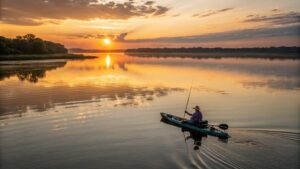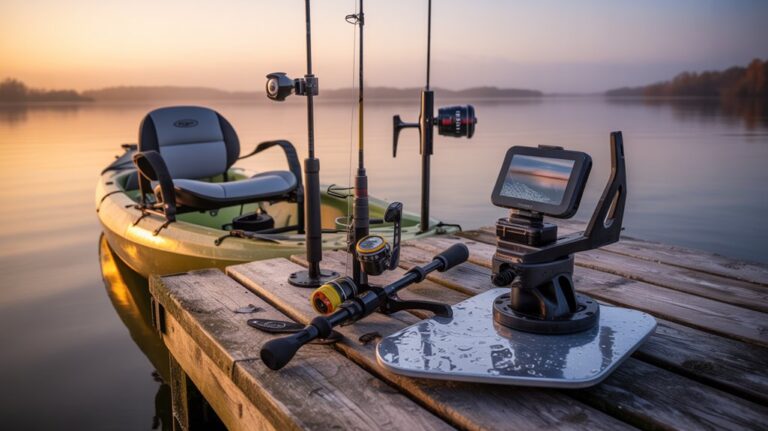To master kayak fishing, you'll need to focus on ten key areas. Start by selecting a stable kayak that's at least 30 inches wide with adequate weight capacity. Practice one-handed casting techniques like sidearm and drop-casting to maintain balance. Keep your gear organized in waterproof containers and within easy reach. Always wear a PFD and check weather conditions before launching. Learn to read water features and use proper anchoring methods. Fish during prime hours (early morning/late afternoon) and adjust your strategy based on seasons. Master efficient paddling techniques and stay stealthy to avoid spooking fish. These fundamentals will transform your kayak fishing success with the right knowledge and practice.
Essential One-Handed Casting Techniques
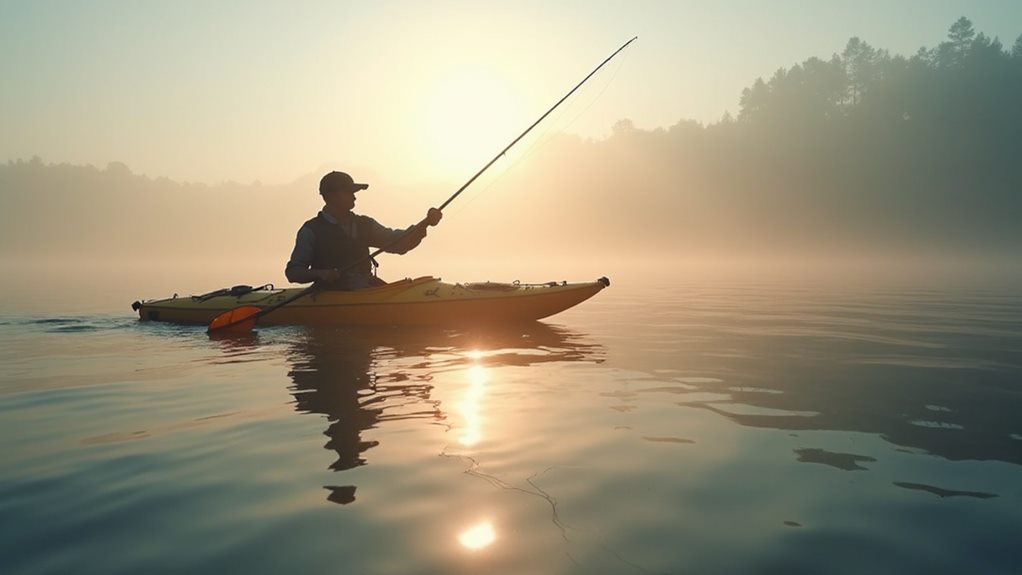
From the confines of a kayak, mastering one-handed casting techniques is fundamental for maintaining balance while landing the perfect catch. Your fishing kayak's stability depends on efficient movements, making single-handed casting methods vital for success on the water. Engaging in kayak fishing not only enhances your casting skills but also provides excellent health and fitness benefits through the physical activity involved. The single-hand sidearm cast should be your go-to technique, as it mimics a tennis stroke that won't compromise your balance. When fish are near the surface, try drop-casting by holding your rod high and releasing the line grip – it's quick and effective. For those tight spots around weeds and structures, master the flipping and pitching techniques to place your lure with pinpoint accuracy.
The roll cast is particularly valuable when you're working in confined spaces. By using a softball-pitch motion, you'll be able to skim your lure across the surface while maintaining control. Remember to adjust your casting techniques based on your proximity to the water – the height difference between you and your target affects both accuracy and balance. These casting techniques will help you adapt to various fishing situations while keeping your kayak steady and your catches consistent.
Navigating Through Different Water Conditions
In challenging water conditions, your kayak fishing success depends heavily on understanding and adapting to the environment around you. When steering through different water conditions, you'll need to adjust your approach based on what you're facing. Start by learning to read water features like current seams and eddies, which will help you position your kayak for ideal casting opportunities. Additionally, employing stealthy paddling techniques can enhance your approach, allowing you to blend into the surroundings and increase your chances of a successful catch.
On windy days, stay close to the shoreline to minimize wave exposure and find sheltered fishing spots. If you're dealing with choppy water, lower your center of gravity by sitting or kneeling in your kayak – this simple adjustment will greatly improve your stability and control. When fishing in fast-moving water, use a quick-release clevis for anchoring, as this safety feature prevents capsizing while helping you maintain your position.
Your paddling technique should adapt to the water conditions you encounter. When fishing in current, paddle upstream before dropping anchor to maintain better control. By mastering these steering skills, you'll be better equipped to handle various water conditions and focus on what matters most – catching fish.
Choosing The Right Kayak
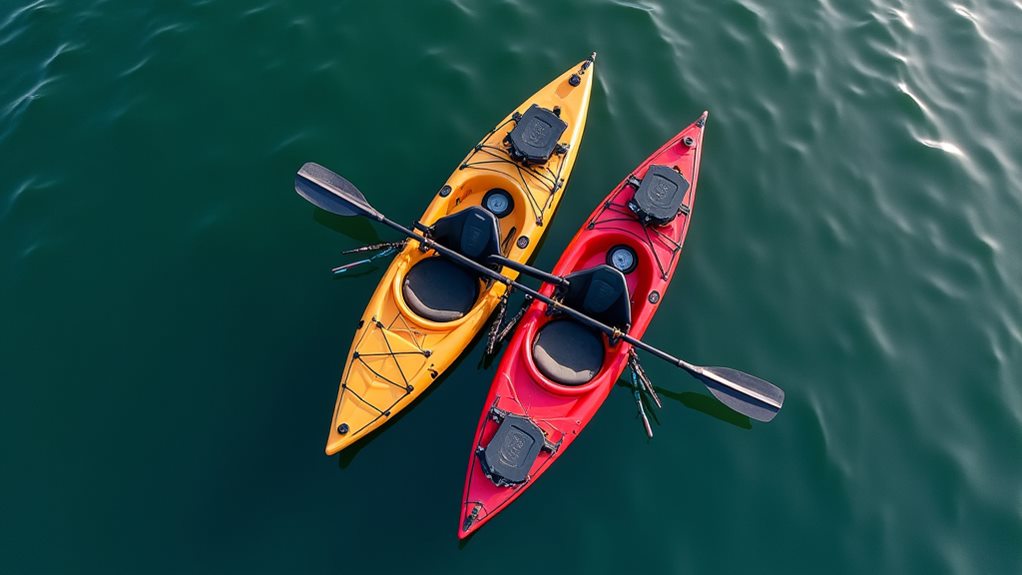
Selecting the right fishing kayak can make or break your angling experience. When you're searching for the Best Kayak for your needs, you'll need to take into account several vital factors that directly impact your time on the water.
First, decide between a sit-on-top or sit-inside design. Sit-on-top models offer easier casting and gear access, while sit-inside versions protect you from harsh weather. Your kayak's length should fall between 10 to 12 feet, balancing stability with maneuverability. For best stability while fishing, look for a width of at least 30 inches.
| Feature | Consideration |
|---|---|
| Type | Sit-on-top vs. Sit-inside |
| Length | 10-12 feet ideal |
| Width | 30+ inches for stability |
| Weight Capacity | 300-500 pounds |
| Material | Rotomolded or Fiberglass |
Don't forget to check the weight capacity – you'll need enough support for yourself, your fishing gear, and your catch. Most fishing kayaks handle between 300-500 pounds. For material choice, think about rotomolded plastic for durability and value, or fiberglass if you're willing to pay more for a lighter option.
Safety Equipment And Precautions
Once you've chosen your ideal kayak, prioritizing safety becomes your next major focus. Your most crucial piece of safety equipment is a personal flotation device (PFD), which you must wear at all times while on the water – it's not just a safety measure but often a legal requirement. Don't risk going without one, even if you're an experienced swimmer. Additionally, consider equipping your kayak with vital gear such as a fishing rod holder and tackle box to enhance your fishing experience.
Before launching your kayak, check local weather forecasts, paying special attention to wind conditions and wave heights. These factors greatly impact your safety on the water. You'll also need to carry a whistle or other signaling device, as sound travels better than voice across open water in emergency situations. Keep a well-stocked first aid kit aboard your kayak to handle any injuries that might occur during your fishing expedition.
Make it a habit to share your planned route and expected return time with someone you trust. This safety protocol guarantees that if something goes wrong, someone knows where to look for you. By following these precautions and properly maintaining your safety equipment, you'll create a secure foundation for enjoying your kayak fishing adventures.
Advanced Anchoring Methods
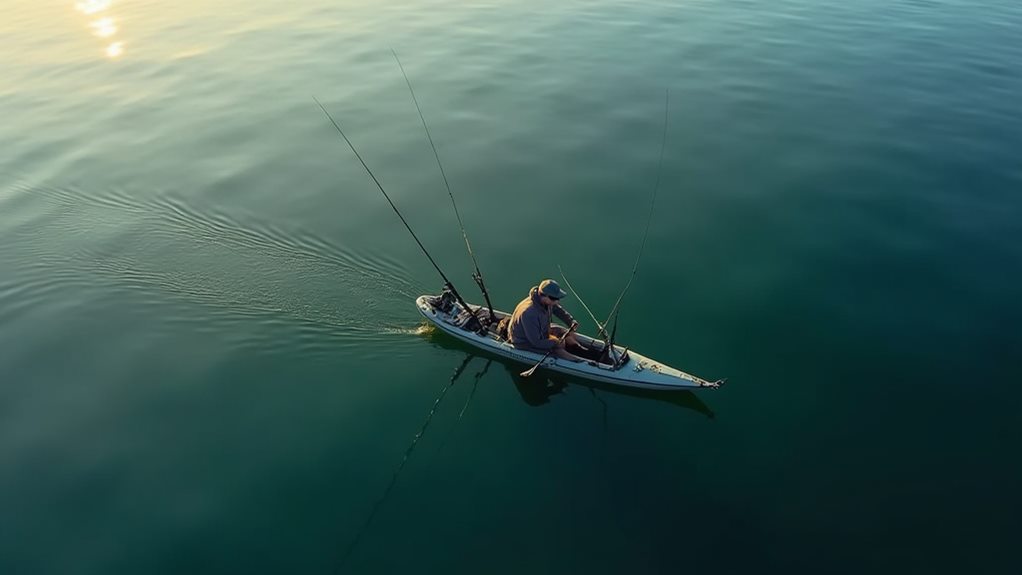
Mastering advanced anchoring techniques transforms your kayak fishing from drifting aimlessly to precision positioning. To maximize stability, you'll want to secure your anchor at either the bow or stern, preventing unwanted sideways movement caused by wind and currents.
Installing an anchor trolley system gives you a considerable advantage by allowing you to adjust your anchoring position on the fly. This versatile setup lets you pivot your kayak while maintaining your position, helping you adapt to changing conditions and target different fishing spots effectively.
Before dropping your anchor, paddle upstream to guarantee your line stays clear. This simple step prevents snags and allows for smoother deployment. If you're fishing in rocky river bottoms, consider using heavy chain instead of traditional anchors. The chain provides better grip while reducing the risk of getting permanently stuck on underwater obstacles.
When it's time to retrieve your anchor, maintain consistent tension on the line. This vital step prevents your kayak from swinging unpredictably and helps you maintain control throughout the retrieval process. These advanced anchoring methods will greatly improve your fishing experience and success rate on the water.
Strategic Fish Finding Spots
Now that you've mastered your anchoring position, let's focus on where to place that anchor for the best results. Your kayak angling success largely depends on targeting the right locations at advantageous times. Estuaries and mangroves should be your prime destinations, as they're natural fish magnets offering both food and protection for various species.
Time your expeditions strategically by heading out during early morning or late afternoon when fish are most active and hunting for food. You'll want to sync your trips with the tides, particularly focusing on the period just before high tide when catching fish is often most productive. Keep an eye on local fishing reports to identify current hotspots and emerging patterns in fish movement.
Look for areas where structure meets shallow water – submerged rocks, fallen trees, or any underwater obstacles that create hiding spots for baitfish. These features naturally attract larger predatory fish, making them ideal targets for your kayak fishing expedition. Position your kayak upstream from these structures, allowing your bait to drift naturally toward the fish's holding areas.
Seasonal Fishing Patterns
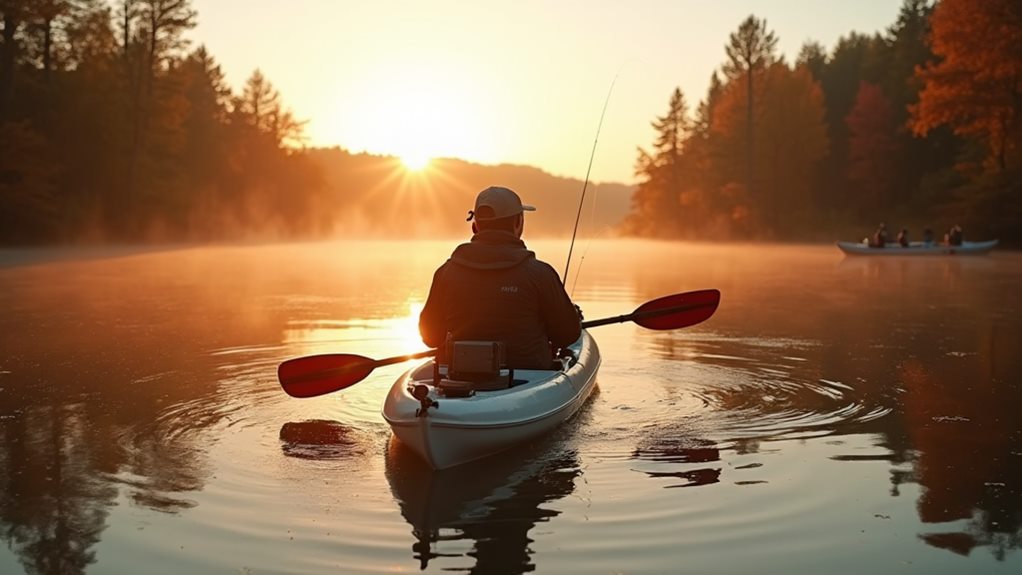
Understanding seasonal fishing patterns can completely transform your kayak fishing success. As seasons change, fish behavior shifts dramatically, requiring you to adapt your approach throughout the year.
In spring, you'll find most species becoming active in waters between 55-65°F during spawning season. This makes it an ideal time for fishing kayaks to target bass and trout in shallower areas. When summer arrives, you'll need to adjust your timing – fish retreat to deeper, cooler waters during peak heat. Many anglers use early morning or late evening hours to maximize their catches during these warm months.
Fall presents excellent opportunities as fish feed aggressively to prepare for winter. You'll want to position your kayak near shallow areas where walleye and pike gather to hunt. During winter, you'll need to be more strategic. Focus on deeper waters or near structures where perch and northern pike tend to concentrate.
To make the most of each season, track local patterns and environmental changes. Pay attention to water temperatures, migration patterns, and feeding habits. These factors directly influence where fish congregate, helping you choose the most productive spots for your kayak fishing adventures.
Tackle Organization Systems
While seasonal patterns guide when and where to fish, your success on the water depends heavily on how well you organize your gear. For kayak anglers, implementing effective tackle organization systems is vital for maximizing your time on the water and maintaining efficiency during your fishing adventures.
Start by investing in tackle boxes with adjustable compartments that'll let you customize spaces for different lures, hooks, and tools. You'll want to protect your gear from water damage by storing items in waterproof bags or dry boxes, which will greatly extend the life of your equipment. Consider using a labeling system for your containers, making it easy to identify and access specific baits or tackle when conditions change.
Install magnetic strips or adhesive hooks within arm's reach to keep important tools like pliers and scissors readily available. This setup prevents you from wasting valuable fishing time searching for basic equipment. Don't forget to regularly assess and declutter your tackle organization systems, keeping only what you actually need. This practice not only improves your kayak's stability but also guarantees you're carrying the most effective gear for your fishing style.
Weather Impact On Fishing
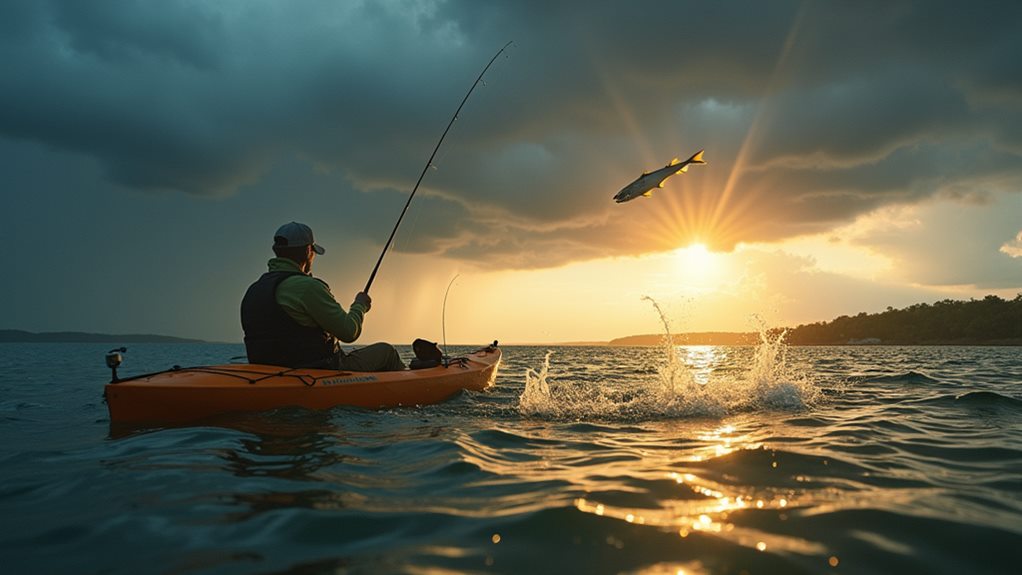
Successful kayak fishing frequently depends on your ability to read and adapt to weather conditions. Understanding weather impact on fishing can greatly improve your chances to catch fish while ensuring a safe experience on the water. Pay close attention to wind conditions, as speeds above 10 mph can make both paddling and casting challenging from your kayak.
Key weather elements that affect your fishing success:
- Overcast conditions work in your favor, as cloud cover encourages fish to feed near the surface where your lures are more accessible
- Rain can increase your catch rate since the water disturbance makes fish less cautious and more likely to strike
- Barometric pressure changes influence feeding patterns, with falling pressure typically triggering more active fish behavior
Time your fishing trips around ideal temperature conditions. Fish are more active in warmer water, so early mornings and late afternoons often provide the best opportunities during hot weather. When planning your kayak fishing adventure, check both the weather forecast and fishing reports to maximize your success. Remember that adapting your fishing strategy to match current weather conditions is essential for consistent results.
Efficient Paddling Strategies
Once you've assessed the weather conditions, proper paddling technique becomes your next major factor for kayak fishing success. As an angler, you'll want to position your hands shoulder-width apart on the paddle to maximize power and control during each stroke. This grip allows you to navigate efficiently while conserving energy for your fishing activities.
To execute precise maneuvers around fishing spots, combine forward and backward strokes for tighter turns. Keep your movements smooth and rhythmic to maintain consistent speed without creating excessive splashing that could scare away potential catches. Your core muscles play a vital role in stability, so engage them while paddling to reduce fatigue and extend your time on the water.
When you encounter windy conditions, don't fight against nature. Instead, position your kayak at an angle into the wind and use shorter, more powerful strokes to maintain control. This technique helps you stay on course while approaching your target fishing areas. Remember that efficient paddling isn't just about moving through the water – it's about creating a stable platform for anglers to cast and reel in their catch while minimizing disruption to the surrounding environment.
Frequently Asked Questions
How to Fish While Kayaking?
You'll need a lightweight rod and reel setup. Keep your paddle accessible while managing one-handed control. Position yourself with the current, use stealthy casts, and match your bait to local fish species.
What Are the Tips for Pedal Kayaking?
You'll want to maintain a shoulder-width grip, adjust your pedal strokes to conditions, keep feet relaxed, establish consistent rhythm, and watch water depth. Shorter strokes help maneuverability while longer strokes maximize speed.
What Lures for Kayak Fishing?
You'll want to pack soft plastic worms, crankbaits, spinnerbaits, topwater lures, and jigs. They're versatile for different conditions and cover types you'll encounter while kayak fishing, without taking much space aboard.
Is Kayak Fishing Difficult?
You'll find kayak fishing challenging at first, but it's manageable with practice. While you'll need to master balance, casting, and gear management, you can become proficient through regular outings and patience.
Final Thoughts
You're now equipped with key kayak fishing skills to make your time on the water more productive and enjoyable. Whether you're mastering one-handed casts, organizing your tackle, or reading seasonal patterns, these techniques will help you become a more confident kayak angler. Remember, safety comes first – always check conditions before launching, and don't forget that practice and patience will steadily improve your skills.

